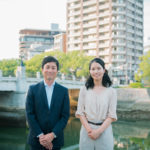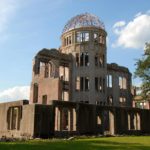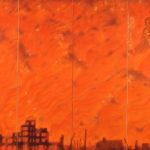Epilogue: Learning from Hiroshima’s Reconstruction Experience: A Small Suggestion for an Incomplete Endeavor
Introduction
The question of “what the reconstruction of Hiroshima signifies” has been addressed in the discussions presented in the previous nine chapters and the nine columns written by 15 experts. Hiroshima began as a castle town and developed into a military capital in the Meiji period, but at one point lost everything in the atomic bombing, including its people, neighborhoods, history, culture, and traditions. However, soon after the bombing the city started on the path to reconstruction, evidenced by the reopening of a portion of a single streetcar line by the Hiroshima Electric Railway three days after the bombing. After defeat in the war, Hiroshima accepted its new fate as a city advocating peace through the war-damage reconstruction plan undertaken by the national government and the enactment of the Hiroshima Peace Memorial City Construction Law.
However, its new identity as a City of Peace did not easily take root. As the city was rebuilt from burnt fields and the citizens’ livelihoods restored, a “peace” mindset gradually took root, after many twists and turns, through the actions of A-bomb survivors and other citizens, supported by individuals as well as various organizations and institutions in society, including those in the administration, education, health care, and the news media.
The following is a review of Hiroshima’s reconstruction as was presented in each chapter.
I Tracing Hiroshima’s Path to Reconstruction
Part 1 War and Destruction
(1) Chapter 1 Modernization of Hiroshima
After Nagoya, Kanazawa and other major towns, Hiroshima was among several large local castle towns of the Edo period. During the modernization that took place after the Meiji Restoration, it became home to the Fifth Division Headquarters of the Imperial Japanese Army in 1888. It developed into a military city in which important military facilities were concentrated through the First Sino-Japanese War and the Russo-Japanese War. In this process, the Ujina Port became a base for military transport, and the peoples’ livelihoods came to depend on the military and government. Commerce, industry, transportation and educational functions also became concentrated in the city, which grew into a major city, with a population surpassed only by the six largest cities in Japan.
(2) Chapter 2 War and Hiroshima, the Devastating Impact of the Atomic Bombing
Military functions were further centralized in the city during the Second Sino-Japanese War, which began with the Manchurian Incident in 1931, and through the Pacific War. Toward the end of WWII, the Headquarters of the Second General Army, which was established to control the units stationed in Western Japan, was located in Hiroshima in preparation for anticipated battles on the homeland. However, the atomic bombing indiscriminately killed about 40% of the population of Hiroshima City (not only killing military personnel but also primarily killing noncombatants). In an instant, the city and all its functions were completely destroyed; not only military facilities but also industrial, transportation and education facilities were devastated along with the culture, traditions and history that had been cultivated by the citizens.
Part 2 Reconstruction of the City
(1) Chapter 3 Reconstruction Planning
The reconstruction of the City of Hiroshima first began with development of urban infrastructure under the national government’s war-damage reconstruction project. Based on the Basic Policy for the Reconstruction of War-damaged Areas adopted by the Cabinet in December 1945, the War Damage Reconstruction Agency, directly under the prime minister, began land readjustment projects in 115 cities in Japan. At the core of the projects were land readjustment and development of streets and parks. In addition, 34 reconstruction plans proposed by citizens, government officials, and foreign people were published in newspapers and at the Hiroshima City Reconstruction Council. Early signs of the city’s identity as a City of Peace were already seen, including preservation of the sites that show the scars of the A-bombing and are symbolic of “peace.”
(2) Chapter 4 The Hiroshima Peace Memorial City Construction Law
In order to overcome the financial difficulties of the war-damage reconstruction project, local people concerned lobbied the national government and the Diet to establish a special law, which was enacted as the Hiroshima Peace Memorial City Construction Law in 1949. With this law, Hiroshima acquired a substantial reconstruction fund and accelerated its reconstruction. It also began its transformation into a “peace memorial city” under Article 1 of the law, stating, “Hiroshima is to be a peace memorial city symbolizing the human ideal of the sincere pursuit of genuine and lasting peace.” A new identity was first bestowed on the city by law, and based on this law the grand symbolic areas of Hiroshima were created, such as the Peace Memorial Park, the Peace Boulevard, and the riverbank greenbelts as we see today.
(3) Chapter 5 Various Problems Surrounding Redevelopment
However, redevelopment of the city as a symbol of peace did not proceed smoothly. Whether it was land readjustment or creating parks and the riverbank greenbelts, the majority of targeted land just after the bombing was charred fields on which many illegal buildings had been built. The first step in the construction of the Peace Memorial City had to begin with the removal of the illegal buildings by the city government (in some locations), amidst calls from citizens protesting the evictions. Illegal buildings had once been lined up along the Aioi Street, by the riverside in Moto-machi; and it was referred to as an “A-bomb slum.” In order to improve the living conditions, high-rise apartments were built for low-income families in the Moto-machi district. This was conducted not by the war-damage reconstruction project but by the “residential areas improvement project.” In this way, shacks were eliminated. Today, the high-rise apartments in Moto-machi have become historic buildings that tell the story of Hiroshima’s reconstruction process.
Part 3 Hiroshima’s Reconstruction and Citizens’ Lives
(1) Chapter 6 Rebuilding of Industrial Economy
The Census of Manufactures data related to the reconstruction of industrial economy in Hiroshima show that Hiroshima City had, from the beginning, a large manufacturing sector in comparison to its population. Due to the atomic bombing, however, numerous factories and workers were lost, and manufacturing suffered a severe blow. It was rebuilt through an inflow of workers from outside the city; active capital investments; contribution of workers including female workers; and the transfer of former military facilities to private ownership. An overall look at Hiroshima Prefecture shows that manufacturing industries (such as shipbuilding) were revitalized by special procurements of the Korean War and by the “Productive Prefecture Plan” announced by Hiroshima Prefecture in 1952. In 1968, the value of manufactured shipments in Hiroshima Prefecture was the top in the Chugoku, Shikoku, and Kyushu Regions. The reconstruction of industrial economy in Hiroshima Prefecture was led by manufacturing until the 1970s.
(2) Chapter 7 Realizing Adequate Healthcare and Medical Care, and Support for A-bomb Survivors
Ninety percent of the physicians and healthcare professionals in Hiroshima City were exposed to the atomic bombing, and most medical facilities were destroyed. During the chaotic period after the war, acute infectious diseases, pulmonary tuberculosis, and venereal diseases spread. However, in 1952 Social Insurance Hiroshima Citizens Hospital opened and health and medical care facilities gradually improved, primarily through public hospitals such as the adjunct hospital of the Hiroshima University Faculty of Medicine. Meanwhile, free medical treatments for the A-bomb survivors began to be offered by the Hiroshima Atomic Bomb Survivors’ Treatment Council, established in 1953. Later, medical care for A-bomb survivors was improved through the A-bomb Survivors’ Medical Care Law and the A-bomb Survivors’ Special Measures Law. The Hiroshima Atomic-bomb Survivors Hospital, established in 1956, and many other health and medical institutions continue to provide treatment to and conducted research for A-bomb survivors.
(3) Chapter 8 Media and Reconstruction
The Chugoku Shimbun represented the local media in Hiroshima before the war and became the prefecture’s only newspaper in 1944. Its circulation had reached 380,000, but it suffered a devastating damage by the atomic bombing. The Chugoku Shimbun rose to convey the devastation of the atomic bombing and has faithfully recorded on its pages facts about the atomic bombing, the realities of the victims, the reconstruction of an A-bombed city, Hiroshima, and the rebuilding of residents’ livelihoods. After the war, the Chugoku Shimbun consistently pursued the themes of “reporting on the atomic bombing,” the “abolition of nuclear weapons,” and on “peace.” The media (represented by the Chugoku Shimbun) recorded Hiroshima’s reconstruction and supported Hiroshima’s search for a new identity.
Part 4 Searching for a New Identity
(1) Chapter 9 A City in Search of Peace
The peace administration of the City of Hiroshima undertook the significant role of promoting a crucial part of the reconstruction process—the creation of a new identity for Hiroshima. The Peace Memorial Ceremony is held on August 6, and the mayor has delivered a peace declaration to the world on behalf of the A-bomb survivors and citizens. The Hiroshima Peace Culture Foundation, which began as a municipal department and transitioned into a foundation, manages the Hiroshima Peace Memorial Museum and conducts peace activities for citizens. In addition, although the peace movements implemented by Hiroshima citizens were vulnerable to the political disputes due to splits in the movement against atomic and hydrogen bombs, they set goals that were specific and separate from politics, such as preserving the A-bomb Dome, elucidating the realities of the atomic bombings, and passing on the experiences of the bombing. These actions gathered proponents and discovered a direction that leads to the NGO activities of today. Furthermore, peace education at elementary, middle, and high schools also has provided opportunities for children to think about the atomic bombings and to pass on the experience of the bombing.
However, the reconstruction of an A-bombed city, Hiroshima cannot be discussed without speaking about the A-bomb survivors. While it is said that only they can talk about their feelings, the questionnaire survey conducted 60 years after the bombings revealed that many of the survivors support the abolition of nuclear weapons and advocate world peace. That earnest hope has supported Hiroshima’s reconstruction, and in recognition of that, numerous people have built up a city that advocates for peace in various ways.
That, perhaps, is Hiroshima’s new identity.
II Conclusion: Learning from Hiroshima’s Reconstruction
Finally, I would like to simply once again explain the significance of this book. First, this is the first full-fledged publication created through a joint project between Hiroshima Prefecture and the City of Hiroshima under the theme, “the reconstruction of Hiroshima.” In the wake of the compilation of this book, it is anticipated that the prefecture and the city will further collaborate on various peace projects. Second, although the majority of the existing literature on the theme of reconstruction focuses solely on tangible aspects, such as city planning and the improvement of infrastructure, this book presents a broad portrait of Hiroshima’s “reconstruction” by also shedding light on intangible aspects, including health and medical treatment, support for A-bomb survivors, the citizens’ lives, the reconstruction covered by the media, and the creation of a new identity rooted in peace.
The writers, too, are not simply a gathering of experts in various fields who chronologically outlined the history of the city’s reconstruction. Rather, in keeping with the theme, they have delineated a reconstruction process that achieved an identity of peace while reexamining heretofore accepted explanations of the reconstruction history, and have spun a new contemporary history.
Given the above implications, the next major issue is what to learn from the reconstruction experience, and how to make the most of it. To do so, I would like to name several lessons learned while tracing Hiroshima’s reconstruction history.
First, destruction in itself does not mean the end. The first step in Hiroshima’s reconstruction began the very instant following the atomic bombing when it seemed that everything had been lost.
Second, reconstruction is an act that generates something new and simultaneously revitalizes what has been handed down from the past and nearly lost. Though perhaps this book did not sufficiently emphasize this point, the reconstruction did not create everything anew. It was also an initiative that brought back social functions, culture, and traditions that had existed in the Hiroshima communities before the bombing.
Third, those who have experienced tragedy are often the ones who most strongly long for peace. Just as with the A-bomb survivors in Hiroshima, they are essential to reconstruction.
Fourth, the road to reconstruction is not a straight path. At times, opposition and clashes can occur. Hiroshima’s redevelopment projects produced friction with citizens in many places. However, reconstruction is even further solidified by overcoming those hardships.
Fifth, achieving reconstruction requires the active awareness of every citizen, even more so than special organizations, leaders, and systems. Certainly, important roles were played by the War Damage Reconstruction Agency, leaders such as the governors and mayors, people of the prefectural and city governments who were in charge, and systems such as the Hiroshima Peace Memorial City Construction Law. However, what ultimately achieved and anchored the reconstruction was the repeated, everyday efforts of individual citizens who possessed and acted with a keen awareness that they were “a part of Hiroshima City, a city of peace.”
(Kazumi Mizumoto)
Tags associated with this article





-150x150.png)

